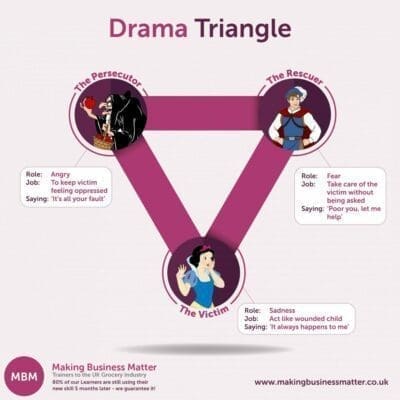The 3 Roles of Karpman’s Drama Triangle
This was a familiar scenario in our home when my kids were small. It was 2008, New Year’s Day. Mum and Dad were worst for wear (Uh-hum) and so to placate the kids we all went out and bought a Wii. ‘You two kids play this whilst Mum and Dad ‘rest’. An hour later I walked into the living room to find a blanket covering the TV. ‘Why has the TV got a blanket over it?’. Gabby was 8, ‘The telly was cold’. Even through my struggling state, I sensed that might not be true.
Lifting up the blanket, the wonderful colours that appeared on the screen were a sight to behold. Though not quite as much as the Wii remote that was buried in the screen. Jack, ‘Do you $££$$$$$ remember I said to put the strap thing around your wrist when you played bowling?!’, I shouted at the kids. My wife heard and came to defend them ‘as they are only little’.
This is the drama triangle.
In this scenario, it is short-lived, typical of young families, and provides amusing stories to ponder on in the later grey-haired years. There are much more unproductive, unhealthy, and toxic drama triangles that we have all been part of.

The Persecutor, The Rescuer, and the Victim
Steven Karpman came up with the drama triangle in the 1960s, winning the Eric Berne Memorial Scientific Award, and the triangle is as relevant today as it was then. The Drama Triangle is about three roles; The Persecutor, The Rescuer, and the Victim. Imagine an inverted triangle with the P top left, the R top right, and the V at the bottom. To bring it to life I’ll share where we see it every day – fairy tales, films, and TV (If yours is not ‘cold’!). Little Red Riding Hood: The Big Bad Wolf was the persecutor (Villain), The Woodsman was the Rescuer (Hero), and Little Red Riding Hood was the Victim (Damsel in distress).
Click on the image below for a high resolution image:

At work, we often play out the drama triangle in our heads moving around all 3 roles. The last time you missed a deadline your brain went something like, ‘You idiot, you knew you should have done that’ – Persecutor. ‘They treat you badly. It’s not your fault’ – Victim. ‘It’s ok, we can sort this’ – Rescuer. The roles also play out in real life too. You might have a boss or a customer that is a persecutor, or you might be that persecutor looking for people to blame. Each of us enters the drama triangle at our default position. For example, you might ‘always’ be the victim. A triangle begins because of a situation, like a missed deadline, and then we play one of the 3 roles, and look to others to be the other roles.
Breaking Out
The challenge with the drama triangle is to know that all 3 roles end up as the victims because we move around the drama triangle until we arrive at, ‘Poor me. Help!’. To break out of this well-trodden road is about firstly knowing that the drama triangle exists, and secondly by taking the step to move your role to something much more positive. A persecutor becomes a positive challenger, the rescuer a coach, and the victim problem solves taking responsibility for the part they play.
Written by Darren A. Smith for The Grocer.




